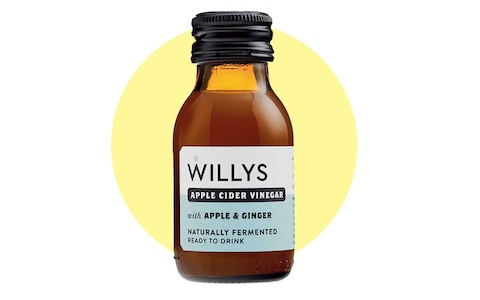
Good For Gut Health, Vinegar Has Never Been More Popular For Health Aficionados. Our Columnist Puts The Best To The Test…
Pucker up: vinegar is the drink of the day. Said to pack a trolley load of health benefits, a shot of apple cider vinegar is this year’s avocado toast.
It certainly ticks a lot of hipster boxes: alcohol-free drinks for grown-ups, fermentation for health, low sugar. Most of the brands on the market are produced on a small scale (which qualifies them for the ‘artisan’ label) and British-made, so ‘local’.
But I had my doubts. First there’s the slogans. ‘Plant-based, gut-loving wellness tonic’ is the sort of rhetoric that makes me want to chomp on a Peperami with a Bacardi Breezer. Then there’s the price. Around $30 for 250ml is not unusual – given that a daily dose is a tablespoonful (15ml), that’s not far off a pound a pop. I rolled my eyes as I mixed up a turmeric, ginger and horseradish number from The Bath Alchemist.
Reader, I’m converted. Not to swigging back an undiluted spoonful: I’ll leave that to the cold-water swimmers and endurance cyclists. But mixed with water – about a tablespoon to 300ml of sparkling is my preferred poison – it’s a savoury-sweet, mouth-filling revelation, as satisfying a flavour as alcohol, without the hangover or the calorie load. And no, not particularly sour at all.
Of course, I’m late to this. There’s nothing new about drinking vinegar. Back in the 5th century BC Hippocrates was recommending a vinegar and honey mix as a treatment for sepsis. Cleopatra teased Mark Antony by dissolving a pearl in vinegar to create a 10 million sesterce (coin) meal. Roman soldiers marched hydrated by posca, a vinegar, salt, and water mix, and it’s that which was offered on a sponge to Jesus at the Crucifixion.
All those were wine vinegars, but fast-forward to modern times, and cider vinegar comes to the fore. In the 1970s, the socks-with-sandal-wearing counterculture types started taking a daily shot, after the publication of Apple Cider Vinegar Miracle System by Paul C Bragg, which promised it could give you ‘a longer, healthier, youthful life’. He had a poor record as a health expert, dismissed by medics as a charlatan and investigated by the Food and Drug Administration, with a history of making false health claims for his products. But improbably, he hit upon something with the vinegar. Bragg Apple Cider Vinegar is still available to buy in wholefood shops.
Studies indicate that, along with fighting diabetes and helping with weight loss, vinegar may help reduce ‘bad’ cholesterol and fight certain cancers. Whether cider vinegar is more effective than others has yet to be shown, but you may want to choose a ‘live’ vinegar, as the bacteria act as a probiotic, boosting your gut’s microbiota.

Which brings me to the two fermentations. To make vinegar, a sugary liquid – apple juice, say – is fermented into an alcoholic one – in this case cider. Then bacteria are added, traditionally in the form of a ‘vinegar mother’, a slimy gloop containing acetobacteria, and the liquid ferments again. During this process the bacteria converts the alcohol into acetic acid. This ‘live’ vinegar may look cloudy, and even have gobbets of vinegar mother floating in it.
You can add this to leftover wine and cider to make your own vinegar: wine will need to be diluted about 2:1 with water, as the acetobacteria need an alcohol content below nine per cent. Simply add the mother to the bottle, cover with kitchen paper and a rubber band (not a lid or cork) and leave for about three months.
You can drink live vinegar just as it is, in a 15ml shot, but at about five per cent acidity, you’ll probably want to dilute it. Or pick a vinegar designed for drinking, which will have flavourings, usually ‘superfoods’ like ginger or turmeric, and sometimes fruit. Some are sweetened: a lightly sweetened vinegar is sometimes called a ‘switchel’, while one with a higher level of fruit is a shrub. But none of them should leave a bitter, or sour, taste in your mouth.
Five of the best drinking vinegars
The Bath Alchemist
( 240ml, The Bath Alchemist)

True vinegars, some lightly sweetened with honey. These will work as finishing vinegars in cooking too: try a few drops on grilled fish. Flavours include turmeric, ginger, horseradish and raw honey.
Willy’s
(15 x 60ml, Willy’s)

Made by Willy Chase of Chase Vodka & Gin, with apples from his 300-year-old orchard. Tiny shot bottles, ready-diluted with juice, and good-value 500ml bottles of live vinegar with mother, which can be used for cooking or drinking.
Mother Root

Developed by a wine trade professional Bethan Wallace Higson when she fell pregnant and needed a ‘feel-good’ non-alcoholic drink. Made with ginger root, orange blossom honey and organic cider vinegar in the traditional switchel style. Drink diluted with still or sparkling water or tonic water.
Nonsuch Shrubs

Founded by former Aspall cider owner Henry Chevallier Guild, Nonsuch Shrubs come in enticing flavours including Bittersweet Apple & Cardamon. Drink diluted with water or use in cocktails.
Jukes Cordialities

Sophisticated concoctions designed by wine expert Matthew Jukes to be in the style of red, white, and rosé. The colours match too, so no one will spot you’re off the sauce. Pricey, but less than a fine wine – dilute with still or sparkling water.








